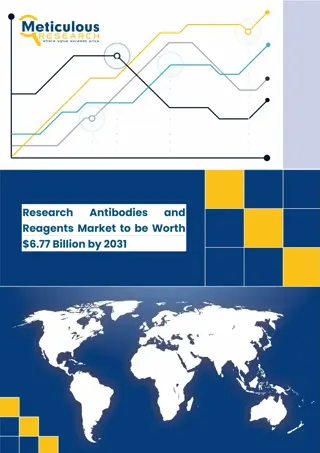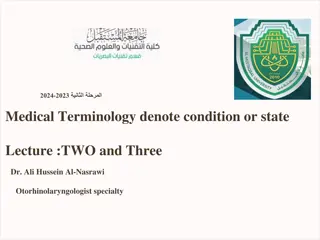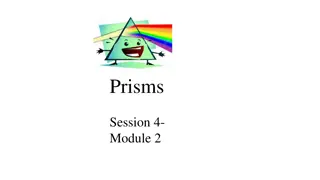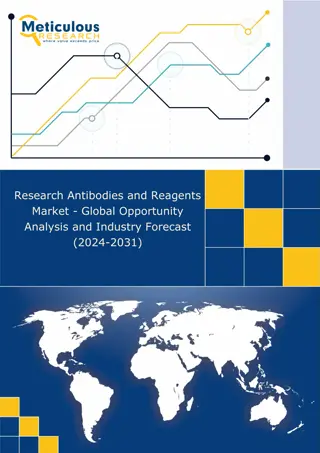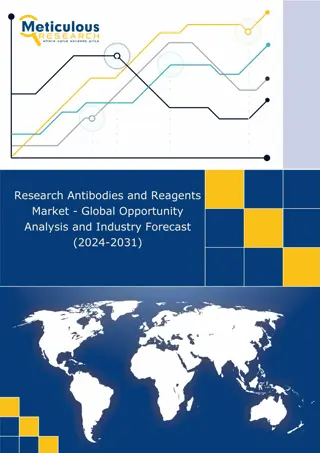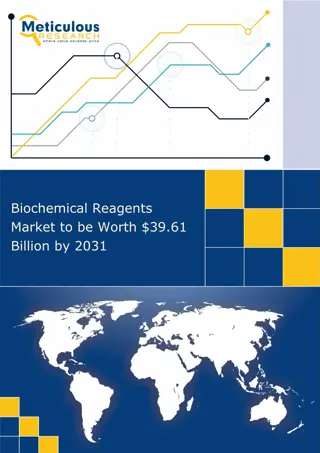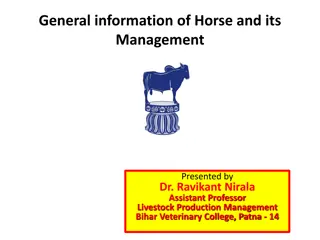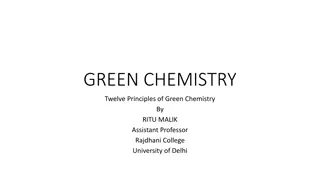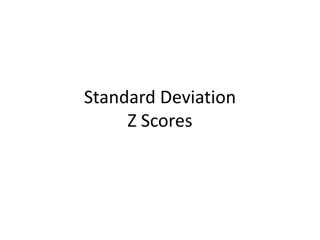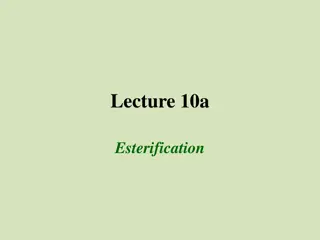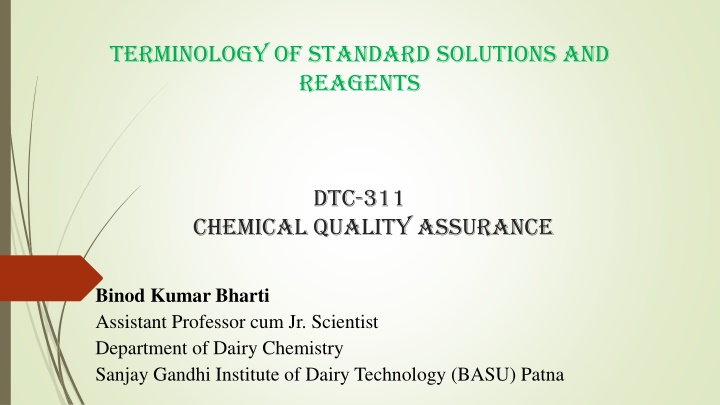
Standard Solutions and Reagents in Chemical Analysis
Learn about the terminology, definitions, and calculations related to standard solutions and reagents in chemical analysis of food and dairy products. Explore the concepts of reagents, solutions, standard solutions, concentration types, and the calculation of equivalent weights for acids, bases, and salts.
Download Presentation

Please find below an Image/Link to download the presentation.
The content on the website is provided AS IS for your information and personal use only. It may not be sold, licensed, or shared on other websites without obtaining consent from the author. If you encounter any issues during the download, it is possible that the publisher has removed the file from their server.
You are allowed to download the files provided on this website for personal or commercial use, subject to the condition that they are used lawfully. All files are the property of their respective owners.
The content on the website is provided AS IS for your information and personal use only. It may not be sold, licensed, or shared on other websites without obtaining consent from the author.
E N D
Presentation Transcript
TERMINOLOGY OF STANDARD SOLUTIONS AND REAGENTS DTC-311 Chemical quality assurance Binod Kumar Bharti Assistant Professor cum Jr. Scientist Department of Dairy Chemistry Sanjay Gandhi Institute of Dairy Technology (BASU) Patna
TERMINOLOGY OF STANDARD SOLUTIONS AND REAGENTS Standard Solutions and Reagents Standard Solutions and Reagents Introduction Standard solutions and reagents are the essential of any chemical analysis of food and dairy products. Purpose of the reagents and solutions for the accuracy, repeatability and precision of chemical analysis of food or dairy products. It is most important that the reagents and solutions should have the correct strength. It should be checked from time to time before use. To express the concentration or strength of solutions and reagents different terms are used in the analytical chemistry or in chemical analysis of dairy and food article. What is Reagent? A substance which can react with another substance or an agent capable of producing a chemical reaction.
What is Solution? A solution is a homogeneous mixture of two or more substances/ components. The component present in higher proportions is called solvent. The component present in smaller proportions is called solute. In common term solute is dissolved in solvent to form a solution. i.e. Solute + Solvent = Solution Dilute Solution:-A solution in which small amount of solute is present is called dilute solution. Concentrated Solution:- A solution in which large amount of solute is present is called concentrated solution. Saturated Solution:- Asolution which contains the maximum amount of solute can be dissolved in a given amount of solvent at a particular temperature is called a Saturated solution.
Standard Solution A solution whose strength or concentration is known is called Standard solution. Concentration or strength of solution can be expressed in 3 different types: i. Normal Solution ii. Molar Solution and iii. Molal Solution i. Normal solution A solution containing 1 gram equivalent of the solute in one litre of the solution is called a normal solution. Eq. wt. is expressed in gm. Normality The number of gram equivalents of a solute dissolved per litre of the solution. Solute may be acid, base or salt. Normality is represented by N . N=???? ?????????? ?? ?????? ?????? ?? ???????? ?? ?????
Eq. wt. of solutes may be acids, bases and salts. 1. Calculation of eq. wt. of acids Equivalent wt. of an acid is generally calculated by dividing the molecular wt. by its basicity. Eq. wt. of an acid =????????? ??. ???????? Basicity of an acid is the number of replaceable hydrogen atoms present in one molecule of the acid. i. e. Acid Molecular Wt. Basicity Equivalent Wt. Hydrochloric Acid (HCL) 36.5 1 36.5 Nitric Acid (HNO3) 63 1 63 Sulphuric Acid (H2SO4) 98 2 49 Oxalic Acid (C2H2O4) 90 2 45
2. Calculation of eq. wt. of alkalis The Equivalent wt. of an alkali is calculated by given formula i. e. Eq. wt. of an alkali = ????????? ??. ??????? The acidity of a base is the number of hydroxyl groups present in one molecule of the alkali. Alkalis Molecular Wt. Acidity Equivalent Wt. Sodium Hydroxide (NaOH) 40 1 40 Potassium Hydroxide (KOH) 56 1 56 Calcium Hydroxide (Ca (OH)2) 74 2 37
3. Calculation of eq. wt. of salts The eq. wt. of salts like carbonate or bicarbonate can be calculated from the equation of its reaction with an acid. ???.?? ?? ????? ????? ??????? ?? ?????? ??? Eq. wt. of salts = For example, Na2CO3 + 2HCl = 2NaCl + H2O + CO2 106 2x36.5 i.e. Eq. wt. of Na2CO3 =????????? ??. =106. =53 2 2 Substance Mol. Wt. Total valency of metals ion Eq. Wt. Sodium Carbonate( Na2Co3) 106 2 53 Potassium Carbonate (K2Co3) 138 2 69 Sodium bicarbonate (NaHCO3) 84 1 84 Potassium bicarbonate (KHCO3) 100 1 100
Mole The quantity of a substance which contains one gram molecular weight or molecular mass of the substance. Molar Solution A solution which contains one mole of a solute per litre of the solution is called a Molar Solution. Molarity The number of moles of solute dissolved per litre of the solution. Molarity is denoted by M . ???? ?? ?????? ?????? ?? ???????? ?? ????? M =
Molal Solution A solution which contains one mole solute dissolved in a Kilogram (Kg) of solvent. Solvent = 1000gm (1Kg), Solute = 1 mole Molality is the number of moles of solute dissolved per 1000gm of solvent. Molality is denoted by m . i. e. Molality (m)=??.?? ????? ?? ?????? ??.?? ??????? (??)
References 1. www.fssaimanual.co.in 2. Ghatak, P.K. and Bandyopadhyay, A.K. (2014) Practical Dairy Chemistry, Kalyani Publishers 3. www,agrimoon.com

